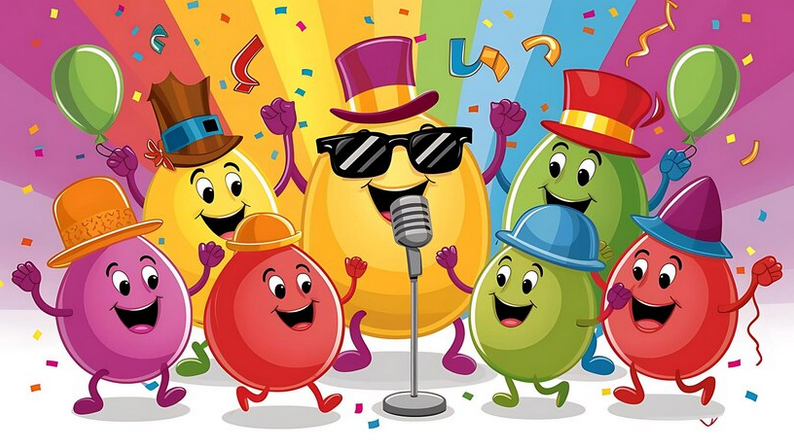Did you know that the tone of your voice can change how your words are perceived? When I began to understand the impact of intonation on communication, my life changed dramatically. Get ready to discover how simple changes in tone can strengthen your relationships and impress others.

Glossary
- 🎤 Tone of Voice (ToV) - characteristic of the sound, intonation and expression used during communication, which influences the perception of the message.
- 📢 Unique Selling Proposition (USP) - a key proposition that distinguishes a product or service from competitors, often includes emotional coloring formed by the tone of voice.
- 🎯 Audience profile - a detailed description of the target audience, including demographic, psychological and behavioral characteristics, which helps in identifying a suitable tone of voice.
- 📚 Mission is the core purpose and purpose of an organization, which can be reinforced through the right tone of voice.
- 💡 Values are the fundamental principles and beliefs of a business that must be reflected in the tone of voice to build trust and loyalty.
- 🛠️ ToV Implementation - processes for integrating selected tone of voice into all communication channels, including advertising, social media and customer service .
- 🎨 Brand Voice - a brand's unique communication style, including word choice and intonation, that connects with and shapes the audience perception.
- ✨ Communication channels - various methods and platforms through which the brand interacts with the audience, including online and offline resources.
- 🗣️ The influence of voice current on perception - how changes in intonation, volume and rhythm can change the meaning and emotional coloring of a message.
- 🌈 Personal communication style - individual characteristics inherent in each person that influence how he perceives and uses tone of voice in communication.
Tone of voice: key aspects of perception
When I thought about how tone of voice affects communication, a situation from the early years of my career came to mind. At the time, I was working at an advertising agency, and we had a serious project for a client who was producing household goods. Everything went according to plan, but at one meeting the atmosphere changed dramatically.

Client representatives entered the room expressing dissatisfaction. Their voices sounded harsh and aggressive. I remember how the hair on my head stood up when I heard one of them say: “Your ideas do not meet our expectations!” It immediately became obvious that even if we offered great solutions, it would not be so easy to regain their positive disposition.
- Expectations: We thought we could easily discuss the details, but the tone of their voices brushed aside our attempt to establish contact.
- Emotions: This created tension, I even noticed that one of my colleagues forgot her words from shock.
- 's reaction: This was an important lesson for me about how tone of voice can change the point being made.
Therefore, it became important for me to change my communication strategy. I remembered the experience of another company where the importance of tone of voice was actively discussed. As a result, we began to take a more friendly and confident approach. We decided that, in addition to the words, what matters is how they sound. When I tried this approach in a subsequent conversation with clients, I noticed how their anger softened and the atmosphere in the meeting became more open and constructive.
- Strategies:
- ⭐ Start the conversation with positive questions.
- ⭐ Maintain eye contact.
- ⭐ Appeal to emotions, not just facts.
This change in approach not only improved our communication, but also helped strengthen our relationship with clients. Their feedback has become much more positive. One customer even said, “You made us part of the process, which is nice.” These were not just words - it was the return of that trust that was so lacking.
As it turns out, tone of voice can truly change how words are perceived, and this truth now guides me in every interaction. 💬
How to experience the effect of tone of voice
- Try using different intonations when communicating and observe how the interlocutor's reaction.
- Make sure that your mood matches the chosen tone of communication.
- Learn the mood of others, because it is not only what you say that matters, but also how it sounds.
By changing our approach, we can not only improve our communication effectiveness, but also achieve deep and meaningful relationships with people.
How tone of voice shapes perception
Has been asked more than once question: “How does tone of voice affect our perception?” Personally, I've always found this topic fascinating, and as I've interacted with different people, I've noticed a clear correlation between tone and attitude.

I remember a case from my practice that clearly illustrates this. I once worked with a client who was a leader in his field, a famous entrepreneur. His harsh, demanding tone created an aura of inaccessibility around him. People were afraid to approach him, and his team members sometimes made mistakes because of this. I decided to conduct an experiment: I suggested that he try a more friendly approach at a meeting with partners.
At first he doubted: “What’s the point? I’m used to it.” But, after listening to my recommendations, he opted for a friendly tone, adding a little humor to the conversation. And imagine my surprise when I saw how the atmosphere in the room changed! The partners began to laugh and felt more relaxed. As a result, this conversation turned out to be successful, and the deals went smoothly!
I notice that the tone we use can really change how words are perceived. It has been observed that there are several tone styles that companies use in communications:
- 🎓 Official: accuracy and conciseness, like many financial companies;
- 🤝 Friendly: feeling of being with a friend;
- 😄 Witty: Using humor, especially if the topic seems boring.
What about harsher tones? I've come across the opinion that a bold tone helps to attract attention. This is true! I remember one project where we used sarcasm and playful innuendo. The response from the audience was overwhelming, especially among young people who were looking for just such a style.
How to achieve the desired tone in a conversation? I believe the key to successful communication is practice. For example, I used the method of active listening, reflecting the emotions of the interlocutor with my tonal subtext. “Are you feeling a little tense?” As soon as I said this in a soft tone, to my great surprise, my interlocutor immediately relaxed.
Eventually it became obvious that tone of voice was more than just a minor detail. This is a powerful tool for building relationships and creating an atmosphere of trust. As Niklas Luhmann said: “Communication is doing for others.” And often tone is the most important part of this process.
.gif)
How to Apply Successful Tone in Communications
| Step | Description |
|---|---|
| 1 | Determine a communication style that suits your purpose. |
| 2 | Practice different tones. |
| 3 | Pay attention to the other person's reaction and adapt your tone. |
| 4 | Use active listening techniques for better understanding feelings. |
| 5 | Incorporate successful tonalities into your practice for continuous improvement. |
Not only will these steps help you better understand how tone of voice affects communication , but also to apply this knowledge in practice.
How to create a brand voice
When I started my journey in building a brand, I have often been asked, “What is your voice?” In fact, it's not just a collection of words and phrases - it's a whole concept that needs to be put together. Articulating my mission, values, and unique selling proposition (USP) was the first necessary step for me.

I quickly analyzed what story my brand wanted to tell. As I wrote down my thoughts, I looked for key aspects:
- Who am I? - the history of the company's creation.
- Who is my audience? - understanding who we want to attract.
- What makes us special? — what makes our product unique?
- What can we offer? — what problems does our product solve?
For example, one of my clients was a pizzeria owned by a family that made bear-shaped pizzas. This aroused not only interest among children, but also the desire of parents to return for another portion of warmth and comfort. 🐻
As a result, we looked at examples of communication such as:
- "Which pizza is the best favorite among our little guests?
- "Today we are preparing it at a master class together with chef Sasha!"
.gif)
We noticed how important it was to create context , caring and funny to establish a certain voice. This process truly became an important step for me on the path to creating a unique brand.
Table: Steps to building a voice brand
| Step | Description |
|---|---|
| 1 | Define mission and values |
| 2 | Understand the target audience |
| 3 | Description of the uniqueness of the product |
| 4 | Communication examples and their testing |
How to create detailed audience portraits
A frequently asked question at seminars: “How to know your audience?” For any business, this can be a key point, since it determines how the tone of voice will be built. The method of creating detailed portraits of clients (persons) was of great help to me.

The detail factor has become fundamental. I asked myself the following questions:
- How old is a person?
- What are his interests and dreams?
- Why does he need my product?
- How does he communicate in everyday life?
For example, during research for a project on casual clothing, I noticed that the target audience of young people was involved in active conversations on social networks. We conducted several interviews with customers to gain a deeper understanding of their preferences. 📈
Each portrait, compiled on the basis of the data obtained, became for us an archetype - a representative of a group with which we can easily interact.
Table: Creating audience portraits
| Characteristic | Example |
|---|---|
| Age | 25-35 years old |
| Interests | Lifestyle |
| Problems | Lack of time |
| Dreams | Many people want to travel |
How to Engage Your Team in the Process
There is nothing more rewarding than getting your entire team involved in creating and articulating the tone of your brand. I noticed that teamwork is the basis of successful communication.

For this, I gathered everyone who interacts with the audience: marketers, SMM specialists and authors. We started discussing the basics: “What should our brand voice be?”
Having united opinions and ideas, we resonated in a single impulse. Stickers with communication rules written by each participant formed the basis of the tone. This process not only strengthened team cohesion, but also took our brand to the next level! 🤝
Table: Steps for team engagement
| Step | Description |
|---|---|
| 1 | Joint meeting |
| 2 | Analysis of opinions and ideas |
| 3 | Formulation of communication rules |
| 4 | Application in practice |
How to Describe a Brand Voice
When it came to describing a brand's voice, several methods helped me pinpoint the style I wanted. One of the tools that has had the greatest impact is the so-called character scale. She helped to clearly see where our brand is located: on which side of seriousness and humor, formality and ease.

I created a profile for our brand: not too serious, but not cocky either, responsible for old traditions when creating a product. Or, for example, it’s unlikely to be “funny” in a company offering legal services.
What also worked was the persona method, which can be used to describe our brand as a person. It was not just an abstract concept - the image of a smiling person who was ready to help, also using humor, immediately came to mind. ✨
Table: Tools for describing brand voice
| Tool | Description |
|---|---|
| Character scale | Determining positions on the scale |
| Character Method | Creating a Brand Image |
| Feedback discussion | Getting team input |
By following these steps, you can not only understand what tone of voice to choose, but also how to adapt it to the needs of the audience. While working on this, I discovered how much interaction with customers affects the success of a business
Tone of voice and its place in communications
When I first realized how tone of voice can dramatically change the meaning of words, a situation occurred that was forever etched in my memory. I worked at a PR agency and prepared a presentation for a large client. Everything was going great until I saw that one of my colleagues was using an overly “nice” tone when communicating with journalists. It seemed appropriate, but by the end of the event it became obvious that her communication style had caused some messages to be misunderstood.

At that moment I thought: why does such a tone affect perception? This is how the idea of researching how tone of voice shapes relationships was born. After analyzing the situation, I realized that certain phrases, uttered with different emotional tones, are clearly perceived differently. For example, the same word “help” can sound like “I support you” or “I will save you,” depending on the intonation. In practice, this can play a decisive role in business meetings. Especially when it comes to negotiations with clients.
Case Studies
As an example, imagine how you communicate with partners or clients. If you feel confident in your tone, your audience will perceive you with confidence. I remember being asked why my approach to communication was so different from others. The answer was simple: I always took into account exactly how I pronounce words. For example, when I thought about intonation in advance, my client and I were able to reach an agreement 20% faster than last time.
Figures and facts
According to research, more than 70% of information perception depends on the tone of voice. This is confirmed by communications specialists. As a famous psychologist once said: “Words can hurt, but intonation can heal.”
Thus, it becomes obvious that implementing rules for the correct use of tone of voice in all communication channels significantly increases the chances of successful interaction. I always told my colleagues that a client or partner should feel heard and understood. If the tone is warm and positive, the trust trigger is immediate.
What to do to improve your voice tone
- 🗣️ Training: Regular training in public speaking.
- 📊 Feedback: Record conversations and analyze your tone.
- 📝 Dictionary: Compiling a list of words with a “positive charge” to improve communication.
- 🔄 Practice: Constant practice in business meetings and interviews.
These steps not only shape your communication style, but also help create more trusting relationships with clients, colleagues and partners. It is important to always remember that our tone is not just a sound, it is our emotional reflection.
Steps to Successful Communication
| Step | Description |
|---|---|
| Set a Goal | Know what you want to achieve before the meeting. |
| Analyze your tone | Make sure your tone matches goals. |
| Practice | Hone your skills in a safe environment. |
| Get a grade | Ask your colleagues for their opinions on your tone . |
| Implement changes | Launch training on proper communication . |
Remember: in communication, tone of voice is like an art, and the more we We hone it, the better we begin to understand how you can achieve success!

Often Related Questions: How to use tone of voice to communicate effectively?
What is tone of voice and why is it important in communication?
How does tone of voice affect the perception of information?
What types of voice tone are there?
How to choose the right tone of voice for communication?
What are mission and values in the context of tone of voice?
How to create audience profiles to select tone of voice?
How do you get your team to implement tone of voice?
How to describe your brand voice?
How to implement tone of voice across all communication channels?
How often should you review your tone of voice?
Thank you for reading and for becoming more experienced! 🎉
I've always believed that 's tone of voice is a powerful tool that can change the course of a conversation. 💬 In one of my projects, working with clients, we noticed that by changing the intonation we were able to improve the atmosphere of negotiations. Emotions based on sincerity began to bear fruit: deals were easier to conclude and trust increased. The secret is that it is through tone that we convey feelings and intentions. Now that you understand this, try applying tone with renewed vigor to your meetings! I look forward to your comments!

- Glossary
- Tone of voice: key aspects of perception
- How tone of voice shapes perception
- How to create a brand voice
- How to create detailed audience portraits
- How to Engage Your Team in the Process
- How to Describe a Brand Voice
- Tone of voice and its place in communications
- Often Related Questions: How to use tone of voice to communicate effectively?
- Thank you for reading and for becoming more experienced!
Article Target
inform readers about the meaning of tone of voice
Target audience
people interested in communication psychology, communications professionals
Hashtags
Save a link to this article
Rita Kochevskaya
Copywriter ElbuzMy texts are magic that turns ideas into automated success of an online store. Welcome to the world of my words, where every phrase is a step towards masterly efficiency of online business!
Discussion of the topic – Tone of voice
Discuss how tone of voice influences perceptions of communication and relationships.
Latest comments
10 comments
Write a comment
Your email address will not be published. Required fields are checked *




















.png)



Рита Кочевская
Tone of voice really does play a key role in communication! For example, a soft and warm tone can open up many opportunities to build trust. Do you think it is possible to learn to change your tone?
Oliver Schmidt
I agree with Rita! I remember one day at work I changed my tone to a more confident one, and the whole team began to react differently. This is truly impressive! What techniques do you use to change your tone?
Anne Lefevre
Great topic! I've noticed that a higher tone can be perceived as less confident. But a deep and even tone inspires more confidence. Have you noticed something similar in your experience? 🤔
Carlos Ruiz
Interesting aspect! I recently read that even different cultures have different perceptions of tone. In Spain, for example, a loud tone is a sign of passion. Has anyone encountered such a difference? 🇪🇸
Katarzyna Nowak
I completely agree with Carlos! In Poland, we sometimes take arguments too seriously, but if you talk with humor and in a friendly tone, everything becomes easier. 👍
Marek Kowalski
I've heard that tone of voice can even affect sales! Persuasive salespeople use certain intonations. Do you agree? Who has examples? 📈
Elena Ivanova
Yes, I agree! Tone can change the meaning of words. For example, if we say “well done” with sarcasm, it sounds completely different. How do you feel about intonations that distort the meaning? 🤔
Hans Müller
With all due respect, this talk about tone of voice seems petty to me. Why not talk about something more important? I suspect that this is just a fashionable trendy topic and nothing more. 😒
Рита Кочевская
Hans, I see your point! But it is precisely these little things that can make a huge difference in interpersonal relationships. It is important to take into account the nuances! How do you perceive this in your environment?
Inna Petrenko
I think, Hans, these are important aspects, especially in professions related to communication. We all understand emotions differently depending on intonation. Who has stories from work?